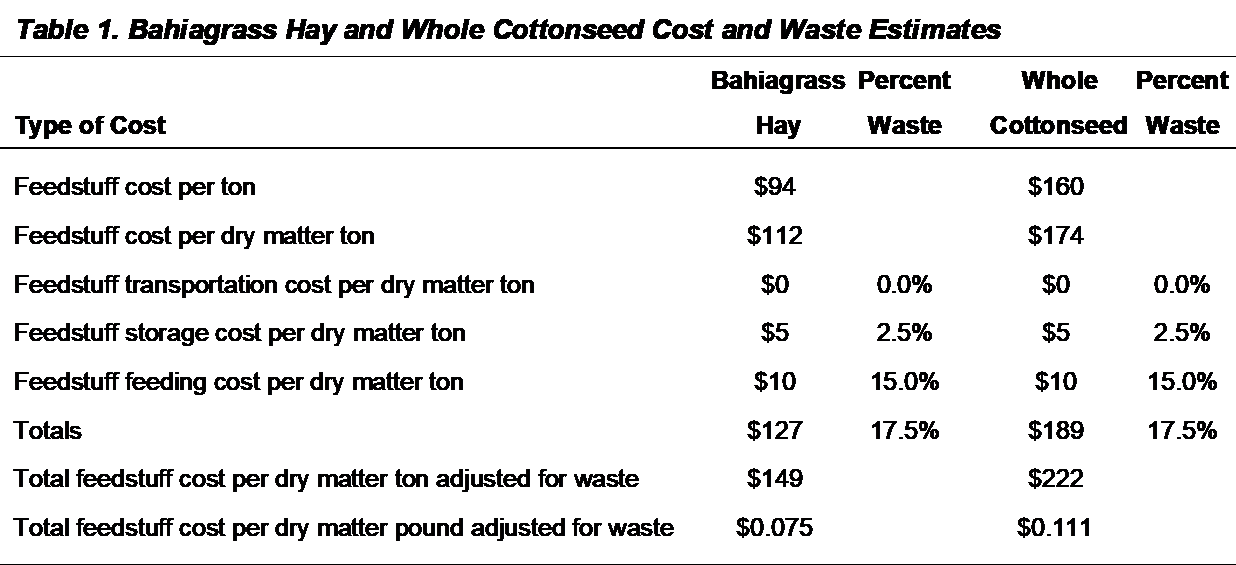
Winter feeding is one of the largest expenses for cow-calf operations in the Southeast. There are a lot of options worth considering, so it is advisable to work closely with the resource people available you, to develop the most efficient plan for your cowherd. Credit: Doug Mayo, UF/IFAS
Chris Prevatt, UF/IFAS Livestock Economist
While the memories of the 2018-2019 winter feeding season are still fresh in your mind, let’s review winter feeding costs for beef cows. Last fall, a beef producer contacted me after purchasing a truckload of bahiagrass hay to feed for his spring-calving cow herd for the winter. The truck was weighed loaded and again after unloading to determine that the average weight of the hay was 894 lbs. per round bale. The bahiagrass hay was then sampled and tested to determine the nutritional value. The values were 84% dry matter (DM), 51% total digestible nutrients (TDN), and 8% crude protein (CP). Therefore, the producer purchased bales of bahiagrass hay that averaged 751 DM lbs./bale. Unfortunately, the energy value of the bahiagrass hay was not adequate to meet the nutritional needs of his spring calving herd. Thus, he also needed to provide some supplement to his cowherd. In this example, he fed whole cottonseed on the ground as his supplemental bulk feedstuff. The nutritional values of the whole cottonseed tested at 92% DM, 90% TDN, and 23% CP.
Table 1 identifies the bahiagrass hay and whole cottonseed costs and waste estimates. The purchase price for bahiagrass hay was $42 per bale delivered or $94 per ton, while the whole cottonseed was purchased at $160 per ton delivered on a bulk feed truck. An adjustment was then made to determine the feed cost per dry matter ton. The total cost of feedstuffs includes the purchase price, transportation cost, storage cost, and feeding costs. In this example, both of the feedstuffs were stored in a commodity barn to reduce storage and feed waste. Table 1 shows that bahiagrass hay costs $149/DM ton, or $0.08/DM lb., and whole cottonseed costs $222/DM ton,or $0.11/DM lb., after adjusting for waste.
Now let’s evaluate the costs of this producer’s winter-feeding program for his spring calving beef cows. The winter-feeding period was from November 15 to March 15 (120 days). His 1,200 lb. spring calving cows (gestating beef cows in their last 1/3 of pregnancy) required a dry matter intake of approximately 24 lbs./day(2.0% of her body weight), 54% total digestible nutrients, and 8% crude protein. Therefore, 19.2 pounds per head per day of bahiagrass hay and 3.6 pounds per head per day of whole cottonseed were fed to meet their nutritional needs. Table 2 shows the costs per beef cow per day, dollars per beef cow over 120 days, and the total cost for our 100-head cowherd.
The estimated cost per head per day was $1.83 per beef cow, or $183 to feed 100 beef cows each day. Over the 120-day winter feeding period, feed costs totaled $220/beef cow and $21,972 for the entire 100-head cowherd.
Take Home Message
Feeding those girls was expensive! It’s important to give this example some thought prior to making a plan for your 2019-2020 winter feeding season. The costs incurred for winter feeding beef cows in this example were large and real. Producers should evaluate alternatives and make adjustments to supplement their beef cows, while meeting their nutritional needs for the least cost possible. The following are some examples of ways this producer might have reduced his costs, compared to the system he chose. He could have:
- Grazed stockpiled forages with supplements for the first 60 days of the feeding period
- Grazed cool-season annual forages for the second 60 days of the feeding period
- Used feeding troughs to reduce supplement waste by 5-10%
- Purchased higher quality hay (Bermuda or ryegrass), if available at a comparable price, to reduce supplement costs. He could have spent an additional $10 per bale, if the TDN was at least 55%.
- Compared other bulk feed options to reduce supplement costs. But, supplement prices vary from year to year, so you have to do your homework.
Winter feeding is one of the largest expenses for cow-calf operations in the Southeast. There are a lot of options worth considering, so this is not a decision that should be made at the last minute. I encourage you to work closely with your county extension agent, successful producers in your area, and with industry representatives to develop the most efficient plan to manage winter the feed costs for your cowherd. As margins get tighter for cow-calf producers, managing costs will become even more important.
- Grazing Stocker Cattle on Warm-Season Annual Forages - August 19, 2022
- Che Trejo wins 2022 UF Top Rancher Challenge at FCA Convention - June 17, 2022
- Marketing Feeder Cattle at 6-Year Highs in 2022 - February 25, 2022


